#claude ii de lorraine
Text
The Fall of Calais
Henri believed that an attack on Calais, the plan for which had been in long gestation, was the surest way to restore French honour. Guise was initially sceptical. In English hands since 1347, Calais was protected by a formidable system of outlying forts which had been modernized during the reign of Henry VIII. Moreover, the campaigning season was late and the Calais pale was dreadfully inhospitable terrain; its marshy and windswept flatlands presented a formidable challenge to supplying an army during the worst months of the year in a country that had recently suffered one of the greatest military disasters of the sixteenth century. Despite his misgivings, Guise had been presented with the opportunity of posing as the saviour of the country and he seized it with alacrity. The campaign exemplifies how the Guise brothers worked together as a team, or as "two heads in one hood", as a contemporary put it. Charles and François left nothing to chance. The final months of the year were dedicated to meticulous planning. An old-fashioned captain in the army, Blaise de Monluc, was astonished that a soldier like François should spend so much time on paper work: "The devil take all these writings for me, it seems he has a mind to save his secretaries labour." The logistical problems of supplying an army of 30-36000 men throughout the winter in country suffering from war fatigue cannot be underestimated. Cardinal Charles busied himself with feeding Mars, using expedients to screw cash from taxpayers and reluctant lenders. "I do not cease day and night," he replied to his brother's urgent demands, "to torment myself to advance your money and to pick all the purses I can find to help you." Squeezing them until their pips squeaked did nothing for his popularity among the common people.
Calais's dozen or so outlying forts amounted to a formidable obstacle. Above the town's main gate was the inscription: "Then shall the Frenchmen Calais win; when iron and lead like cork shall swim." Its main weakness was its old-fashioned castle, which had been overlooked by Henry VIII's engineers. The English were caught off-guard by an attack outside the campaigning season. The suddenness of the attack on 1 January allowed the French to capture a number of outlying forts and bring the town within cannon range. The French were thoroughly prepared for the terrain, to the point of having made pitch-covered mats to serve as artillery platforms on the marshes. They were helped by the cold weather which froze the shallower marshes, enabling their guns and equipment to cross the treacherous ground easily. After two days of bombardment from across the river Hames a breach was made in the castle walls. The river was fordable at low tide and the duke advanced, waist-deep in the water, at the head of several companies, while diversionary attacks elsewhere drew off the defenders. His troops took the castle with ease and put the garrison to the sword. He retired to camp, leaving his brothers, Aumale and Elbeuf, to hold the castle against two bloody English counter-attacks. On 8 January Lord Wentworth sued for terms. He and several English lords were held for ransom (though they were eventually released) and the rest of the garrison and all those inhabitants who wished to leave were given safe passage to the Flemish border. Guise captured a significant quantity of military supplies and commercial goods, which he shared among his captains [..]
The fall of Calais shocked Europe in its daring and its challenge to the traditional ways of war.
Stuart Carroll - Martyrs and Murderers: the Guise Family and the Making of Europe
#xvi#stuart carroll#martyrs and murderers: the guise family and the making of europe#house of guise#la prise de calais#françois de guise#charles de lorraine guise#cardinal de lorraine#claude ii de lorraine#duc d'aumale#rené ii de lorraine guise#marquis d'elbeuf#henri ii
5 notes
·
View notes
Text
The Funeral of Claude of Lorraine, Duc de Guise – July 1, 1550
The Funeral of Claude of Lorraine, Duc de Guise – July 1, 1550
16th Century Italian Funeral procession in Padua 1583
“My son, my friend, if Fortune does me the wrong of taking him [her husband] from me, I will do with the honest people that I have here the best that I can, and you shall be advised of everything. For, my friend, after God, I can have no hope and consolation save in you and my other children. I cannot be without grief so great that in truth I…
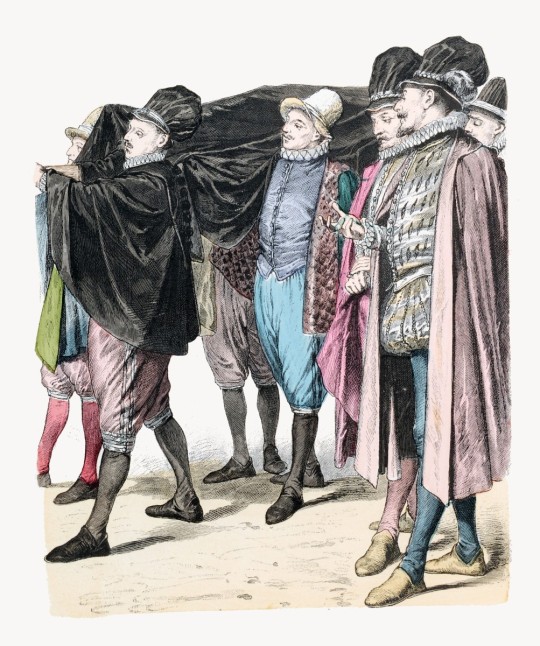
View On WordPress
#Antoinette de Bourbon#Cardinal Jean de Lorraine#Claude of Lorraine#Duc de Guise#Duchess of Guise#Duke of Guise#Francois de Lorraine#French history#Henri II#King of France#Renaissance history
0 notes
Text




On November 22nd 1515 Mary of Guise, was born.
Mary was the eldest daughter of Claude of Lorraine, Duke of Guise, and quite the matrimonial catch. A tall and lithesome woman, she was also intelligent and brave, and proved her worth many times over as both a duchess and the Queen of Scots.
By her first marriage, to Louis d’Orléans, 2e duc de Longueville, on Aug. 4, 1534, she had one son, François, duc de Longueville. Widowed in 1537, she married King James V of Scotland in 1538, frustrating the hopes of England’s King Henry VIII for her hand. But James died on Dec. 14, 1542, a few days after the birth of their daughter, Mary Stuart.
In April 1554, James, 2nd earl of Arran, resigned, and Mary of Lorraine replaced him as regent for her 12-year-old daughter. At first she reconciled the religious factions under her rule, arranging, with Protestant support, her daughter’s marriage in 1558 to the Dauphin (later King Francis II) of France.
Apparently, however, pressure from France caused her to abandon her policy of religious toleration and to attempt the suppression of Protestantism in Scotland. By initiating legal proceedings against a number of reformist preachers in 1559, she sparked an uprising at Perth. The Protestant lords then drove Mary from Edinburgh and on Oct. 21, 1559, proclaimed that she was deposed. With French assistance she recaptured Edinburgh, but an English army helped the Protestants by besieging Leith in April 1560.
The ailing regent took refuge in Edinburgh Castle and on her deathbed urged the nobles of both parties to dismiss the armies of France and England and pledge to support her daughter. Her wishes were fulfilled soon after her death, but ultimately Mary Stuart proved unable to rule Scotland.
Along with the pics of Marie, the other photos are of memorials plaques to her at Edinburgh Castle and South Leith Parish Church.
9 notes
·
View notes
Photo
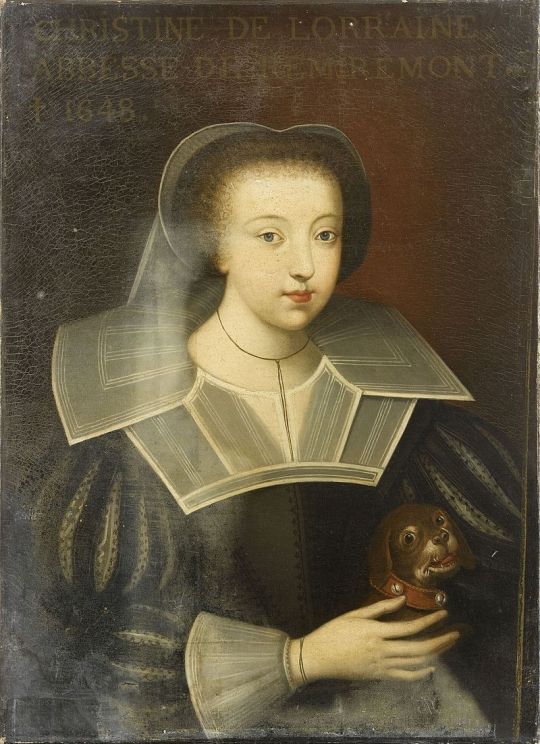
Catherine of Lorraine (3 November 1573 – 7 March 1648) was the Abbess of Remiremont.
Catherine was the seventh child and fourth daughter of Charles III, Duke of Lorraine, and his wife Claude, daughter of Henry II of France and Catherine de' Medici. Her mother died in childbirth in 1575 when Catherine was a year and a half. She was born at the Ducal Palace of Lorraine in Nancy, capital of the Duchy of Lorraine.
Catherine was devoted to religion and even went as far to ignore an alliance with the future Holy Roman Emperor, Ferdinand II.
In 1602 Catherine became the Coadjutrice of the Abbey. In 1612 she became the Abbess of the prestigious Remiremont Abbey, a Benedictine abbey near Remiremont, Vosges, France. The previous abbess, Elizabeth of Salm, had resigned specifically for Catherine to take the post.
Remiremont was one of the most important, illustrious and aristocratic Abbey in France and was closely associated with the House of Lorraine. She later became the coadjutor to her niece, Margaret. Margaret had lost her mother in 1627 and went to live with Catherine at Remiremont. The young Marguerite was later the Duchess of Orléans as wife Gaston, scandalous brother of Louis XIII. Margaret, as a result of marrying Gaston without royal permission, was sent into exile with her husband in Brussels.
In 1638 the troops of Turenne occupied Remiremont for a month. The following year the Princess obtained the neutrality of Vosges (for Epinal, Remiremont, Bruyère, St Dié, Arches) for the rest of the Thirty Years War.
She died in a Lorraine which had been ravaged by the Thirty Years war. At her death, the abbey was given to her great niece Élisabeth Marguerite d'Orléans who ruled the abbey under a regency of her parents, the Duke and Duchess of Orléans.
Remiremont was ruled by two more Lorraine princesses; Élisabeth Charlotte (1700–1711) and then Anne Charlotte (1714–1773).
10 notes
·
View notes
Text
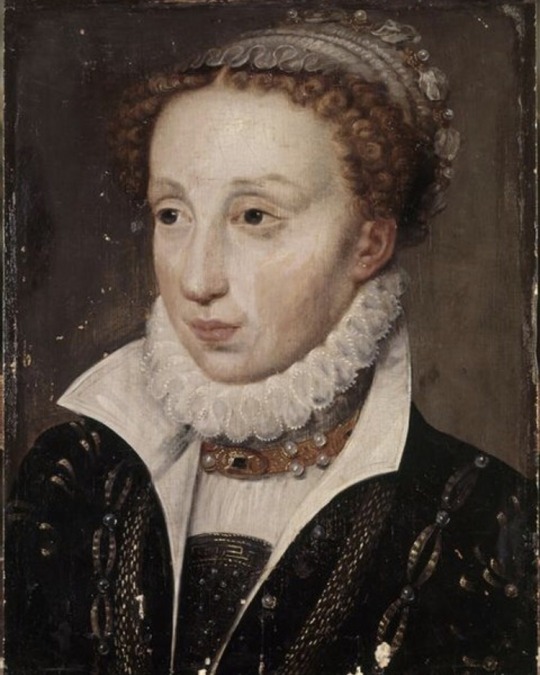
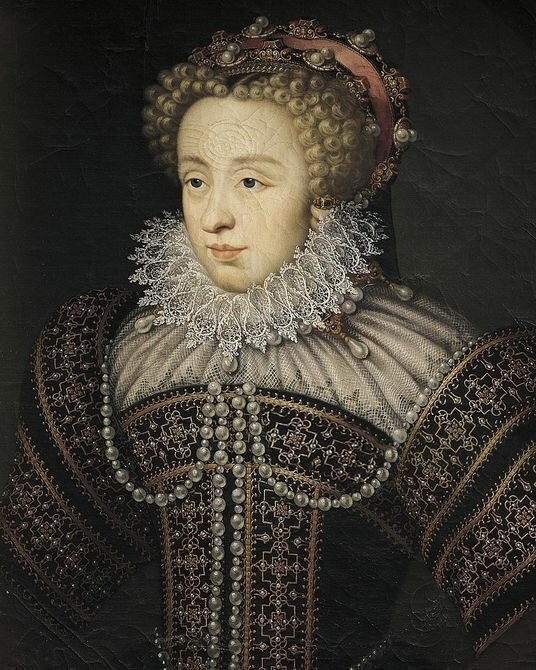
Claude of France, Duchess consort of Lorraine (1547–1575):
(…) Claude, Duchess of Lorraine, left France first. During Henri II’s reign her husband, Charles III of Lorraine, had been largely brought up at the french court where he had been held as a guarantee of the duchy’s good behaviour. Charles and Claude contracted a happy marriage and because their state lay on the eastern border between France and the empire the couple were able to make frequent visits to Catherine, later bringing her grandchildren with them.
Catherine de Medici: Renaissance Queen of France by Leonie Frieda.
42 notes
·
View notes
Text


Henry II, also called (until 1547) Duke (duc) d’Orléans, (born March 31, 1519, Saint-Germain-en-Laye, near Paris, France—died July 10, 1559, Paris), king of France from 1547 to 1559, a competent administrator who was also a vigorous suppressor of Protestants within his kingdom.
He was the second son of Francis I and Claude of France, Henry was sent with his brother Francis, the dauphin, as a hostage to Spain in 1526 and did not return to France until 1530, after the conclusion of the Peace of Cambrai. When the dauphin died in 1536, Henry became heir to the throne. Strong differences between Henry and his father were accentuated by the rivalry between Henry’s mistress, Diane de Poitiers, and the king’s, Anne, Duchess d’Étampes, as well as by Henry’s continuing support of the constable Anne de Montmorency, who had lost favour with the crown. Henry’s reputation has suffered by contrast with his father’s brilliance, and his melancholy made his character unsympathetic. Although he continued many of his father’s policies, he dismissed many of his father’s ministers and raised Montmorency and the house of Guise to favour.
Upon his accession, Henry undertook administrative reforms. The functions of the different sections of the king’s council became more specialized; the commissaries sent into the provinces “to exercise the king’s orders” were the forerunners of the intendants; and intermediary tribunals were established between the local justices and the parlements (high courts). In foreign affairs Henry continued his father’s warfare against the Holy Roman emperor Charles V.
He signed the Treaty of Chambord in 1552 with the German Protestant princes, promising them troops and subsidies; in return, they agreed to France’s taking the bishoprics of Metz, Toul, and Verdun.
A bigoted Roman Catholic, Henry was rigorous in the repression of Protestantism, which was approaching the zenith of its power in France. In 1547 he created the Chambre Ardente in the Parlement of Paris for trying heretics. His Edict of Écouen (1559) laid the ground for systematic persecution of the Protestants.
Though Henry made a truce with Charles in 1556, war was soon resumed when a French expedition was sent into Italy under François, Duke de Guise (1557). The Spanish in the Netherlands, however, besieged the town of Saint-Quentin in Picardy, and Montmorency was defeated in an attempt to relieve it. After Guise had somewhat improved the situation by taking Calais, Guînes, and Thionville, the financial difficulties of both France and Spain and Henry’s desire to fight Protestantism in France led to the Peace of Cateau-Cambrésis (1559).
The Peace of Chateau-Cambrésis was to be cemented by the marriages of Henry’s daughter Elizabeth and his sister Margaret to Philip II of Spain and to Emmanuel Philibert of Savoy, respectively. In a tournament during the festivities, Henry was hit in the head by a lance of Gabriel, Count de Montgomery, captain of the Scottish guard, and died 10 days later. He left four sons by his marriage to Catherine de Médicis: the future kings Francis II, Charles IX, and Henry III and François, Duke d’Alençon and later Duke d’Anjou. In addition to Elizabeth, he had other daughters by Catherine—Margaret, who married Henry of Navarre (the future Henry IV), and Claude, who married Charles III the Great, Duke of Lorraine. One of his natural children was Diane de France, who was legitimatized.
#history#perioddramaedit#edit#history edit#henri ii#henry ii#henry ii of france#french history#16th century#catherine de medici#histoire de france#house of valois#valois dynasty#henri de france#roi de france#henri ii of valois#henry of valois#eric bana#francis i#francis i of france#diane de poitiers
41 notes
·
View notes
Text
Piranesi is psycho-geographical in the stairway.
Claude Lorrain is psycho-geographical in the juxtaposition of a palace neighborhood and the sea.
The postman Cheval is psycho-geographical in architecture.
Arthur Cravan is psycho-geographical in hurried drifting.
Jacques Vache is psycho-geographical in dress.
Louis II of Bavaria is psycho-geographical in royalty.
Jack the Ripper is probably psycho-geographical in love.
Saint-Just is a bit psycho-geographical in politics. (Terror is disorienting.)
Andre Breton is naively psycho-geographical in encounters.
Madeleine Reineri is psycho-geographical in suicide. (See Howls in Favor of de Sade.)
Along with Pierre Mabille in gathering together marvels, Evariste Gaullois in mathematics, Edgar Allan Poe in landscape, and Villiers de l'Isle Adam in agony.
Debord, exercise in psychogeography
14 notes
·
View notes
Text
Life beyond Henry VIII
Christina of Denmark, most famous for sassily rebuffing Henry VIII’s proposal of marriage by saying she’d only marry him if she had TWO heads, lived as interesting a life as any of the Tudors.
Her father Christian II of Denmark was so hated in that country that history now calls him “Christian the Tyrant”. He was overthrown by his own uncle and exiled to the Netherlands, then ruled by his brother-in-law, the Holy Roman Emperor Charles V.
Christina grew up an exiled princess without a kingdom, the daughter of a black mark on European royalty.
She married young and was widowed soon after.
Her cousin was Philip II, who later married Mary Tudor...then Elisabeth de Valois (the French princess)...then his niece Anna of Austria...
Christina actually met Mary Tudor, who was jealous of Christina’s closeness to Philip, a closeness her own marriage to the Spanish prince and future king was lacking.
After refusing to marry Henry VIII, Christina married the Duke of Lorraine and had several children with him, including Charles III. Her husband died after four years of marriage, leaving Christina to fight with the other nobles over the regency for young Charles. Christina won the regency...and then lost it. But she wasn’t going to give up without a fight, not even when France invaded the duchy of Lorraine and demanded that Christina hand young Charles over to the French king, Henri II, to raise in France.
She went to King Henri in person to beg him not to separate her from her son, but he wouldn’t relent and took her son anyway. Charles would later marry Henri’s daughter Claude in one of the few happy and loving marriages in the Valois family history. Charles and Claude later named one of their daughters after Christina.
Also, Henry VIII wasn’t the only person Christina turned down. She also turned down one of Mary Queen of Scot’s uncles, a member of the Guise clan. She blamed the Guise for Henri’s invasion of Lorraine.
Funnily enough, Charles wasn’t the only member of his family to marry into the Valois family. Charles’s cousin Louise married Henri de Valois, known in history as King Henri III...aka, the possibly gay French king...(who history buffs on Tumblr should embrace as their bisexual goth problematic fave, just saying).
According to writer Brantome, Christina also met Mary Queen of Scots after the young queen was widowed by her beloved, the young King Francis II. Mary’s uncle warned her ahead of time about Christina’s theatrical antics and her need to be the center of attention, behavior the Guise party found both annoying and amusing. I wonder what Christina would have thought of the Scottish queen, daughter of ANOTHER woman who turned down Henry VIII with a sick burn.
Christina may not have attended her son Charles’ wedding to the Princess Claude, but she did attend the coronation of the new king of France, ten-year-old Charles IX...who could barely keep his large crown still on his little head. Brantome wrote that Christina showed up in her finest velvet gown with a carriage drawn by Turkish horses (her favorite type of horses). When she arrived in this pomp and splendor, even Catherine de Medici remarked: “There’s a proud woman!”
Christina tried to offer every piece of advice to her son Charles while he was Duke of Lorraine, while her daughter-in-law Claude listened to her mother’s every advice on what to do with Lorraine. The poor couple probably never caught a break from two very nosy and very opinionated mothers and mothers-in-law.
It’s a pity that Reign never mentioned Lorraine, or Christina, her son, and tons of other colorful personalities from France during the 1550s and 1560s. I feel like the writers would have had so much fun featuring a sassy smack down between Catherine de Medici and Christina of Denmark.
Reign really failed to show how important the Guise family was to Mary. There’s a whole goldmine of storylines from history that the show sadly skipped over.
#Reign#Reign cw#cw reign#Christina of Denmark#Christina of Lorraine#Christina de Lorraine#Duke of Guise#Mary Stuart#Mary Queen of Scots#Catherine de Medici#Claude de Valois#Claude Valois#Charles IX#Henri III#Henry III#Louise de Lorraine#Charles III#Charles III de Lorraine#Henry VIII#Marie de Guise#Duke of Lorraine#Duchy of Lorraine#Christian II#Charles V#Philip II#Mary Tudor#Mary I
34 notes
·
View notes
Text
task 001: character sheet
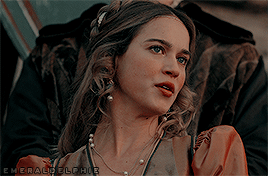
BASIC INFORMATION
FULL NAME : isabeau marguerite valois
MEANING :
name: isabeau, the medieval french variant of isabel (which is itself a variant of the name elizabeth), means “my god is an oath”
middle name: marguerite, the french form of margaret, means “pearl” and also refers to the french name for the daisy flower
surname: valois, the dynasty into which isabeau was born
MONIKERS / NICKNAMES : izzy & beau by her brother louis. some other family members refer to her as ma choupinette
TITLE :
madame royale
et fille de france
dowager duchess of burgundy
dowager duchess of anjou
princess isabeau of france (she was not given the style madame royale upon birth)
GENDER & PRONOUNS : cisfemale & she, her, hers
ETHNICITY : white
DATE OF BIRTH & AGE: october 27, 1528; 30 years old
ZODIAC SIGN : scorpio
ORIENTATION : heterosexual/heteroromantic (to be fair, isabeau is probably bisexual and biromantic, but she’s never had reason to explore that before, so i’ve labeled her as she would label herself)
MARITAL STATUS : widowed; currently betrothed to ferdinand of lorraine
OCCUPATION : madame royale of france
CURRENT LOCATION : sasso corbaro castle, switzerland.
BACKGROUND
PLACE OF BIRTH : palace of fontainebleau
RESIDENCES : château de chenonceau
RELIGIOUS VIEWS : roman catholic; quite pious
EDUCATION : as a daughter of the king of france, isabeau was educated according to her status. her education was handled entirely by her mother and tended toward religion, languages, history, and the arts, both visual and musical.
LANGUAGES SPOKEN :
french (fluent)
latin (fluent)
german (fluent)
spanish (fluent)
english (fluent)
portuguese (moderate)
russian (moderate)
polish (weak)
italian (weak)
ALLEGIANCES :
house valois of france: by birth
house schleswig-holstein of germany: by betrothal
ottoman empire: by alliance
FAMILY :
king francis II: eldest brother
duke charles of orléans: brother
duke louis of alençon: brother
queen claude of brittany: sister-in-law
duchess clothilde of orléans: sister-in-law
dauphin henri of france: nephew
marquess adhémar of orléans: nephew
viscount jacques of orléans: nephew
OTHER FAMILIAL RELATIONS : n/a at the moment
APPEARANCE
FACECLAIM : matilda lutz
HAIR COLOUR / STYLE : dark golden blonde; her hair is usually bound in braids or twists and covered in a golden net with jewels for decoration. however, isabeau often adapts depending on who she is seeing that day. if she was to see someone from a country that often wore their hair loose, she would likely do the same.
EYE COLOUR / SHAPE : blue; roundish-almond eyes
HEIGHT : 152 cm/5 feet
BUILD : slim; isabeau has some muscle that comes from horseback riding, but that is the extent of her physical exertion
SPEECH STYLE : isabeau has a very parisian accent and her tone of voice is melodic. she pronounces things rather easily and does not put too much emphasis on any particular syllables. she is very formal with those she does not know well (read: everyone) and that often shows with the words she chooses.
RECOGNIZABLE MARKINGS : isabeau has a small scar below her collarbone that came about from playing with louis as a child. it is approximately two inches long.
BEAUTY HABITS : isabeau uses cosmetics to ensure that she always looks her best; her hair is often styled and curled if it is left down and she would not ever be seen in public without her rouge and lip paint applied.
PERSONALITY
TROPES : arranged marriage, parental favoritism (gender), stepford snarker, unequal pairing, youngest child complex
INSPIRATIONS : catherine of aragon, giuliano de’ medici (the younger), cher horowitz, blair waldorf (if you squint)
MBTI : estj-t (the executive)
ENNEAGRAM : type 8 (the challenger) with 8w7 wing
ALIGNMENT : neutral evil
TEMPERAMENT : choleric, melancholic, & sanguine (all within 1 point of each other)
HOGWARTS HOUSE : gryffindor
POSITIVE TRAITS : generous, affectionate, intelligent, articulate
NEGATIVE TRAITS : caustic, sarcastic, self-centered, rash
HABITS : when nervous, isabeau will often clasp her hands in front of her abdomen. When she is in a good mood, she’s often seen smiling while her fingers push wisps of hair behind her ears. isabeau also attends daily mass first thing in the morning
HOBBIES : horseback riding, playing the harp, reading poetry, dancing, discussing theology, viewing art
USUAL DEMEANOR : how they usually portray themselves / may be the first impression taken from them.
HEALTH
PHYSICAL AILMENTS : none at this time
NEUROLOGICAL CONDITION : isabeau has suffered from depression and anxiety, though she has developed coping mechanisms
PHOBIAS : autophobia (fear of isolation)
ALLERGIES : she has seasonal allergies, but they are not diagnosed. as such, isabeau suffers through several months of watery eyes and sneezes if only so she can have flowers in her rooms.
SLEEPING HABITS : isabeau sleeps around seven hours per night, though she often takes naps in the afternoon when she is given the time to do so. she wakes up with some frequency and though she is loathe to admit it, she hates sleeping alone.
SOCIABILITY : isabeau is generally sociable and enjoys parties and spending time with others. however, she is much less sociable in switzerland if only because she half-expects that when she leaves switzerland, it will not be to go home to france.
ADDICTIONS : isabeau is a heavy drinker and has been since the death of her first husband. she tends to prefer wine and it is rare to see her without a goblet already in hand.
7 notes
·
View notes
Photo
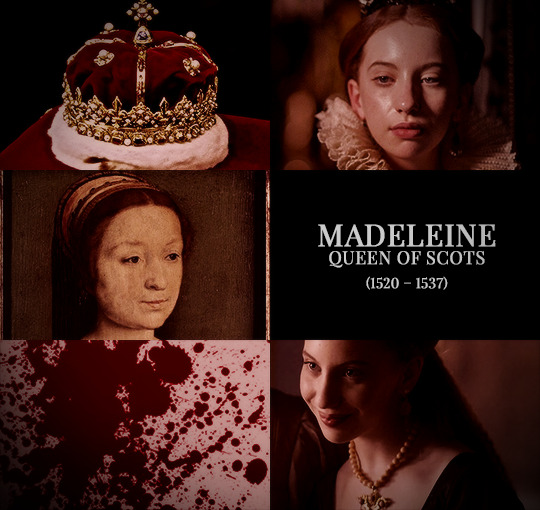

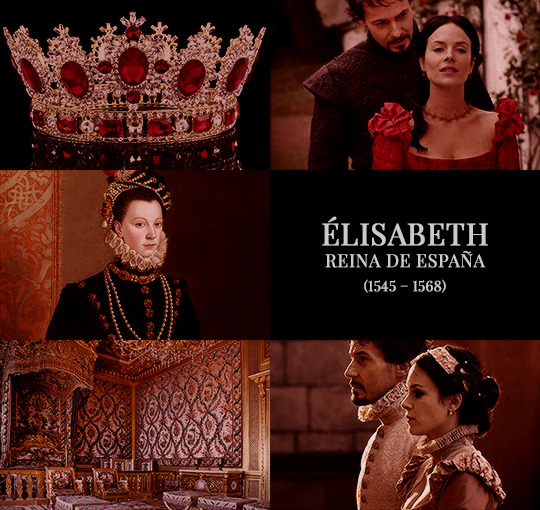
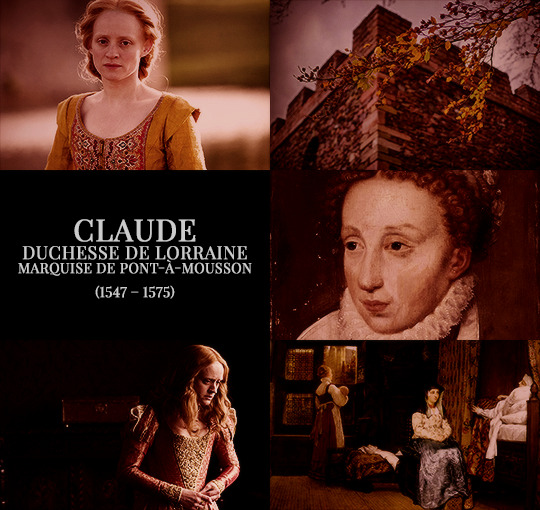


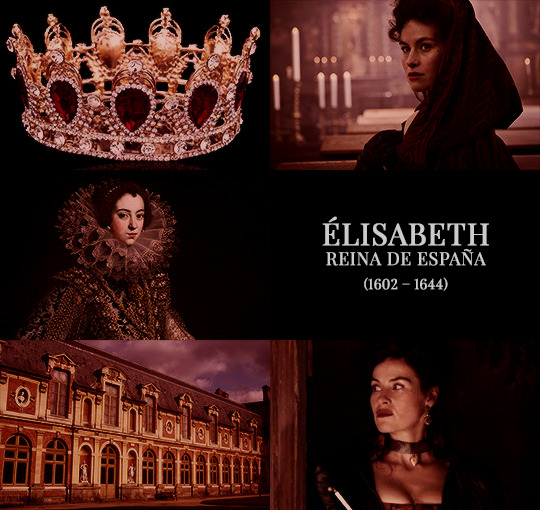
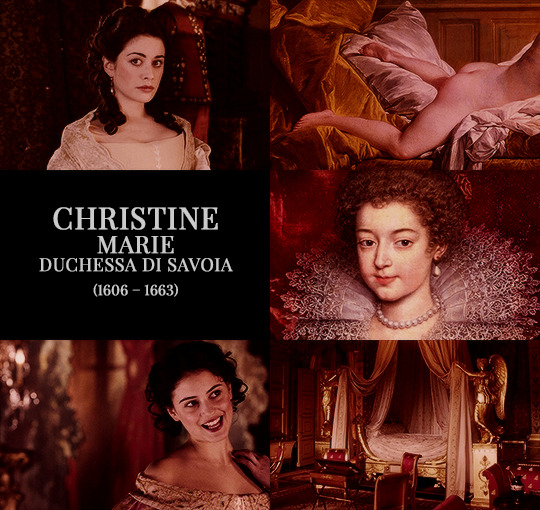
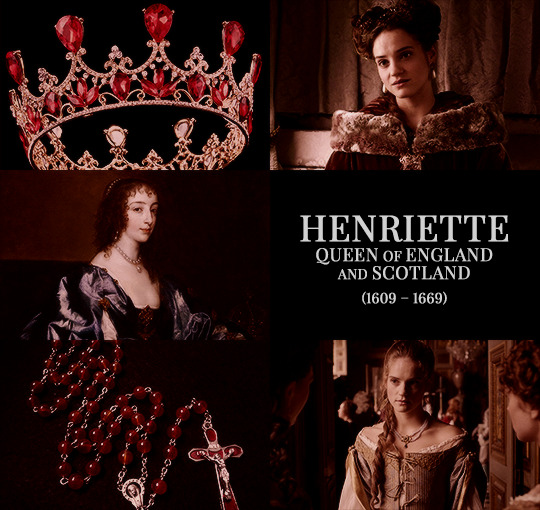
Capetian princesses aesthetic, part IV
Madeleine, Queen of Scots. Daughter of François I and Claude de France.
Marguerite, Duchessa di Savoia. Daughter of François I and Claude de France.
Élisabeth, Reina de España. Daughter of Henri II and Caterina de’ Medici. Mother of Isabel Clara Eugenia de Austria, governor of the Spanish Netherlands and Catalina Micaela de Austria, Duchessa di Savoia.
Claude, duchesse de Lorraine. Daughter of Henri II and Caterina de’ Medici. Mother of Christine de Lorraine, Granduchessa di Toscana and Élisabeth de Lorraine, Herzogin von Bayern.
Marguerite, reine de Navarre. Daughter of Henri II and Caterina de’ Medici.
Marie-Élisabeth. Daughter of Charles IX and Elisabeth von Österreich.
Élisabeth, Reina de España. Daughter of Henri IV and Maria de’ Medici. Mother of María Teresa de Austria, reine de France.
Christine Marie, Duchessa di Savoia. Daughter of Henri IV and Maria de’ Medici. Mother of Luisa Cristina di Savoia; Margherita Violante di Savoia, duchessa di Parma; and Enrichetta Adelaide di Savoia, Kurfürstin von Bayern.
Henriette Marie, Queen of England. Daughter of Henri IV and Maria de’ Medici. Mother of Mary, Princess Royal and Henriette Anne, duchesse d’Orléans.
#house of capet#house of valois#house of bourbon#historyedit#french history#european history#women's history#history#nanshe's graphics#30000 posts#royalty aesthetic
217 notes
·
View notes
Text
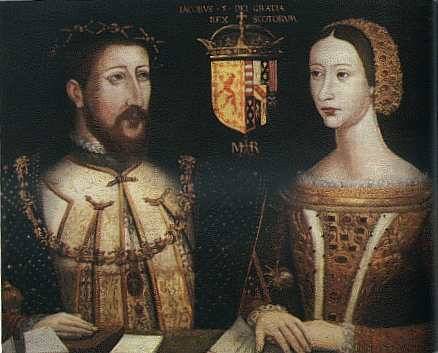
On May 18th 1538 King James V was married to Marie de Guise by proxy at Notre-Dame de Paris.
James's first wife, the fragile french princess, Madeleine of Valois had died within two months of her arrival in Scotland and for the sake of The Auld Alliance it was imperative a new bride bride was found by the French for the Scottish King. While the Scottish reformation was not yet in full swing, unlike in England where his uncle Henry VIII in had swept away the Catholic church and proclaimed himself as head of the Church of England James V avoided major structural and theological changes to the church and used it as a source of income and for appointments for his illegitimate children and favourites. France looked on afraid that the reformation could affect the bond between themselves and Scotland.
And so it was that less than a year after his young bride died in his arms, Robert Maxwell, 4th Lord Maxwell stood in for the groom. Maxwell was a member of James V of Scotland's royal council and served as Lord Provost of Edinburgh in 1524, 1527 and 1535. He was also an Extraordinary Lord of Session in 1533. In 1537, and was one of the ambassadors sent to the French Court to negotiate the marriage.
James V’s second bride was Marie of Guise, the eldest daughter of Claude of Lorraine, Duke of Guise, head of the House of Guise, and his wife Antoinette de Bourbon. Marie had been previously married to Louis II d’Orléans, Duke of Longueville for three years before he died. Marie had one surviving son, three-year-old François, whom she was forced to leave in France as he had succeeded his father as Duke of Longueville. James V and Marie married in person at St. Andrews on June 12th later in the year.
The pic is a contemporary 16th Century portrait of the couple, displayed in the Long Gallery of Hardwick Hall in Derbyshire. A later copy is on display at Falkland Palace in Fife.
8 notes
·
View notes
Photo
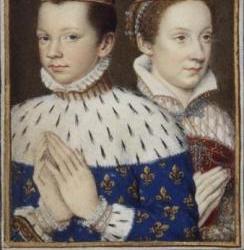
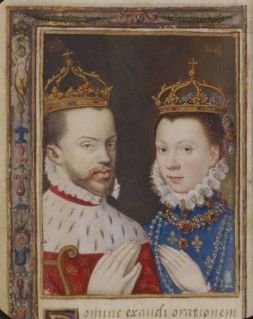

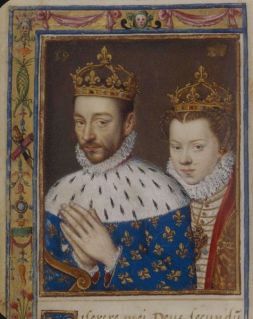

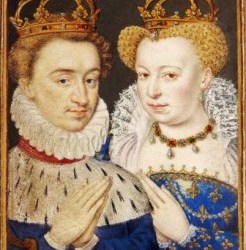
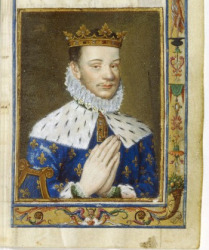
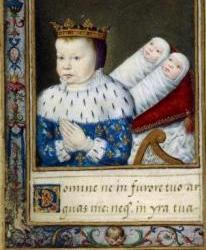

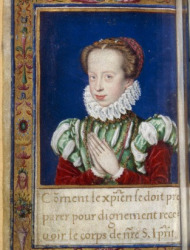
Catherine de’ Medici’s Book of Hours. Bibliothèque national de France.
Mary ,Queen of Scots and Francis ll of Valois
Philip II and Élisabeth de Valois
Charles III, duc de Lorraine et de Bar Claude de Valois
Charles IX de Valois and Elisabeth of Austria
Henry de Valois
Henry of Navarre and Marguerite if Valois
Francois of Valois
Louis of Valois with his twin sisters Victoria and Joan.
Luise de Vodemont, wife of Henry of Valois
Cristine of Lorraine, daughter of Claude de Valois and Carles de Lorraine
54 notes
·
View notes
Photo
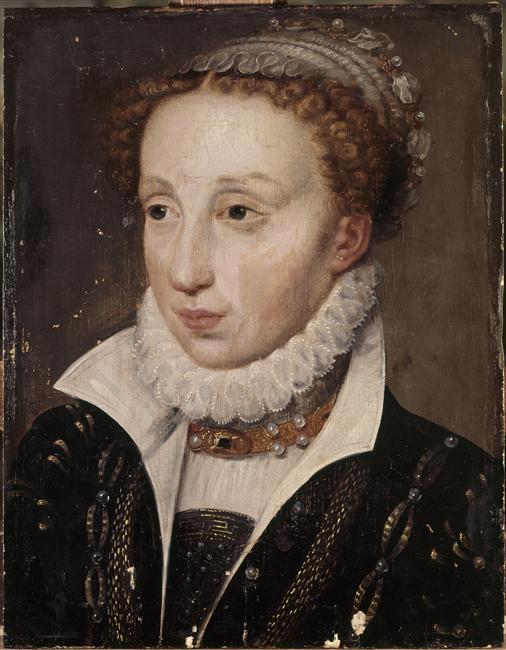
Claude of France (12 November 1547, in Fontainebleau – 21 February 1575, in Nancy) was a French princess as the second daughter of King Henry II of France and Catherine de' Medici, and Duchess of Lorraine by marriage to Charles III, Duke of Lorraine.
5 notes
·
View notes
Text
top 5′s (pt i)

i | lucifer/the devil
ii | ariel from the tempest by william shakespeare
iii | viola from twelfth night by william shakespeare
iv | anansi (akan mythology)
v | figaro from la folle journée, ou le mariage de figaro by pierre beaumarchais

i | la belle et la bête/beauty & the beast (france)
ii | the erlking/erlkönig (german)
iii | barbe bleue/bluebeard (france)
iv | the boy and the wolves (native american)
v | taketori monogatari/the bamboo-cutter and the moon-child (japan)

i | l.v. beethoven's 6th (pastorale) symphony in f major, op. 68
ii | the music of ralph vaughan williams (e.g., symphony no. 3, flos campi)
iii | vergil, eclogues
iv | alexander pope, pastorals
v | the landscape paintings of claude lorrain

(let’s make that 5, yes?)
i | caspar david friedrich, "monastery graveyard in the snow" (1817-19)
ii| paul delaroche, "herodias" (1843)
iii | caravaggio, "judith beheading holofernes" (1598-1599)
iv | john martin, "pandemonium" from paradise lost (1841)
v | john atkinson grimshaw, “princes dock hull” (1883)

i | chelsea arts ball
ii | rothschild ball
iii | truman capote’s black & white ball
iv | all the balls in waugh’s vile bodies ("masked parties, savage parties, victorian parties, greek parties, wild west parties, russian parties”, etc etc etc)
v | the ball from visconti's il gattopardo
126 notes
·
View notes
Text
Contact us here if you wish to play one of them: https://thetudors.forumotion.com/t3171-france

Jeanne d'Angoulême, Countess of Bar-sur-Seine-Dame de Givry, Baroness of Pagny and of Mirebeau, was the illegitimate half-sister of King Francis I of France.
Souveraine of Angoulême -was the illegitimate half-sister of King Francis I of France. In 1534 Married French Ambassador Louis de Perreau, Sieur de Castillon.
Madeleine of Angoulême-was the illegitimate half-sister of King Francis I of France
Arabella Pisseleu Valois- illegitimate daughter of King Francis I of France, with his mistress Anne de Pisseleu d'Heilly.
Elodie Quebec- lady in waiting . A fictional character, hers story is all yours to make.
Jacqueline Jacobs- Lady in waiting at French court. A fictional character, hers story is all yours to make.
Jacques Guillemeau- physician at french court, a fictional character, his story is all yours to make.
Jane Rushmont[/b]- Cousin to Philippe Chabot, Ambassador of France. A fictional character, hers story is all yours to make.
Charles de Lorraine - 2nd cardinal de Lorraine, one of the foremost members of the powerful Roman Catholic house of Guise and perhaps the most influential Frenchman during the middle years of the 16th century. He was intelligent, avaricious, and cautious.
Claude of Lorraine, was a French aristocrat and general. He became the first Duke of Guise in 1528. He was the second son of René II, Duke of Lorraine, and Philippa of Guelders. He was educated at the French court of Francis I. At seventeen, Claude made an alliance to the royal house of France by a marriage with Antoinette de Bourbon (1493–1583), daughter of François, Count of Vendôme.
René of Guise,Marquis d'Elbeuf-was the youngest son of Claude, Duke of Guise and Antoinette de Bourbon.He served as French ambassador to Scotland, and accompanied his sister Mary of Guise on her entrance to that country in 1561. He was also a patron of the arts, particularly of composer Pierre Clereau of Lorraine.
Constance Kelly- lady in waiting to Ava Lafontaine, Duchess of Brittany and younger sister to Claude Valois Queen of France. A fictional character, hers story is all yours to make.
Francis de Lorraine II- was a French soldier and politician. By religion, he practised catholicism, at a time when France was being polarized between the Catholics and Huguenots.
Henry D'artagnan-[/b]Duke of Artagnan, and council member of Francis I court, a fictional character, his story is all yours to make.
[b]Gustavo Chabot- Duke of Bourbon, and brother to Philippe Chabot, a fictional character, his story is all yours to make.
Tristan Hilliard - Duke of Chambord, a fictional character, his story is all yours to make.
Brigitte Rousselot - lady in waiting to Queen Claude, later becomes a mistress of Charles Brandon.
Louis Castillon-Sieur de Castillon was the French ambassador to England during the reign of Henry VIII. He served at the English court from November 1537.
Antoine Duprat was a French Cardinal and politician, Lord of Nantouillet, Count of Valtellina, Britain, and of the Duchy of Milan, was chancellor of France.
Francis III, Duke of Brittany - eldest son of Francis I and Queen Claude and dauphin as well. (Dies in 1536)
Charles II de Valois - Duke of Orleans
Margaret of France - Duchess of Berry
Emmanuel Philibert - Duke of Savoy and husband of Margaret of France
Anne duc de Montmorency-was born at Chantilly to the ancient Montmorency family. His father, Guillaume, had a senior status in the household of the king Francis I. As a young boy he was brought up with the future King Francis I and they became close. In 1512, aged 19, Montmorency fought at the Battle of Ravenna.
Richard Snyder-Knight
Antoine Escalin de Almars-he was a French Ambassador to the Otttoman Empire from 1541 to 1547 and ("General of the galleys") from 1544., he was born in 1498 he is also known as Captain Polin
]Louis II of Orleans - Duke of Longueville; husband of Mary of Guise
Louis d'Amboise - Lord of Bussy. Fictional
0 notes
Text
Patrilineal Descent
As Isabella is born an Archduchess of Austria she is part of the Habsburg-Lorraine dynasty by birth. Her ancestors include Emperors, Kings, and Queens from every European Catholic house in existence, but the patrilineal descent is something Isabella can trace back almost 1,000 years by the House of Lorraine.
1. Archduke Carl Christian of Austria
2. Archduke Carl Ludwig of Austria
3. Charles I of Austria (last Emperor of Austria-Hungary)
4. Archduke Otto of Austria
5. Archduke Karl Ludwig of Austria (father of the famous Archduke Franz Ferdinand of Austria)
6. Archduke Franz Karl of Austria (father of Emperor Franz Joseph of Austria & Emperor Maximilian of Mexico)
7. Francis II, Holy Roman Emperor (last Holy Roman Emperor & first Emperor of Austria)
8. Leopold II, Holy Roman Emperor (First Holy Roman Emperor of the House Habsburg-Lorraine & brother of the famous Marie Antionette, Queen of France)
9. Francis I, Holy Roman Emperor (husband of Maria Theresa)
10. Leopold, Duke of Lorraine
11. Charles V, Duke of Lorraine
12. Nicholas Francis or Nicholas II, Duke of Lorraine
13. Francis II, Duke of Lorraine (son of Claude of France & grandson of Catherine de’Medici, Queen of France)
14. Charles III, Duke of Lorraine
15. Francis I, Duke of Lorraine
16. Antoine, Duke of Lorraine
17. Rene II, Duke of Lorraine
18. Frederick II, Count of Vaudémon or Frederick II of Lorraine
19. Antoine, Count of Vaudémont
20. Frederick I, Count of Vaudémont
21. John I, Duke of Lorraine
22. Rudolph, Duke of Lorraine
23. Frederick IV, Duke of Lorraine
24. Theobald II, Duke of Lorraine
25. Frederick III, Duke of Lorraine
26. Matthias II, Duke of Lorraine
27. Frederick II, Duke of Lorraine
28. Frederick I, Duke of Lorraine
29. Matthias I, Duke of Lorraine
30. Simon I, Duke of Lorraine
31. Theodoric II, Duke of Lorraine
32. Gerard, Duke of Lorraine (First Duke of Lorraine)
33. Gérard de Bouzonville, Count of Metz (Born c. 1030, Died 1070)
3 notes
·
View notes